
Ludwing van
Beethoven:
Music in silence
Dilmika Tennakoon
Ludwing van Beethoven is a German Composer born to a musical family
in 1770. Both his father and grandfather were musicians. His first
teacher was his father and he was trained to play the piano at a very
tender age.
|
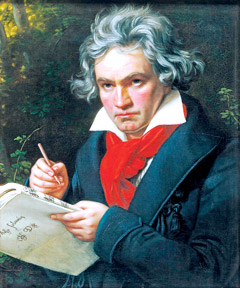
Ludwing van Beethoven |
The Beethoven family became poor after the death of his grand father
in 1773. His father became a drunkard. By age 11 Beethoven left school
due to the financial difficulties and at the age of 18 he became the
breadwinner. At the age of 25 Beethoven made his first public appearance
as a composer and a pianist, on a day just like today. But he gave up
playing for composing due to his sudden, progressive deafness.
Compositions
Beethoven was the first Romantic composer. He bridged the gap between
the classical period and the Romantic era. He was the first composer to
succeed without the support of a patron. He adapted classical forms to
express powerful emotions such as the sprit of humanism and nationalism.
Beethoven’s powerful style of composing, particularly in the
symphonies and piano sonatas caused a stir in the late classical period.
He became famous for composing nine symphonies. He dedicated his Eroica
symphony to Napoleon. But when Napoleon made himself Emperor, Beethoven
scratched out the dedication.
His many master pieces which we now regard as his greatest creations
were strongly criticized during that time. His seventh symphony was
criticized, claiming that its composer was “quite ripe for the madhouse”
by Weber who was also a musician.
The tragedy of his life became more acute after he went completely
deaf. Critics said that “Horrors of sound” in his work were because he
could not hear them himself. Fidelio opera was criticized as an
incoherent, coarse, wild and ear splitting composition. However
Beethoven dominated a whole period of musical history.
No other period of musical history is completely dominated by one
composer like him.
Most of his masterpieces were composed during the last 10 years of
his life when he was quite unable to hear.
Last days
He had studied under Mozart and Haydn. Some of his early compositions
were influenced by those masters. But he guarded his own independence of
outlook and possessed his own style when it came to composition. In art
he was neither classicist nor a romanticist, but his aim was to be a
realist and express the truth from music.
Beethoven was a loner. He could not find a partner in life though he
sensed the world more than any other musician. In his last days he spent
his time in a shabby room and was haunted by his misfortune. He suffered
from insomnia, which did not bring him joy in the last days of his life.
He was isolated in a world surrounded by silence.
His final words were “Clap hands, friends; the play is over.” A great
composer passed away on March 26, 1827. His funeral took place on March
29 with the presence of thousands of people.
Scientists say that Beethoven died due to lead poisoning. Beethoven
became the legend that he is only after his death.
Unexplained
Ringing rocks of Pennsylvania
|

The stark demarcation between the boulder field and the
surrounding forest is strange |
Ringing Rocks Park is a 128 acre park nestled in the woods in Upper
Black Eddy. Located within the park is a field of boulders, about seven
to eight acres in size, that have an unusual property. When the rocks
are struck with a hammer or another rock, they sound as if they are
metal and hollow and ring with a sound similar to a metal pipe being
struck.
|

A visitor demonstrating the standard rock banging technique.
Only a fraction of the rocks actually ring. The others, when
struck, make just a dull clunking noise as one would
normally expect when rocks are struck. Why some rocks ring
and other don’t is also a mystery |
The boulders are made of a substance called diabase which is
basically volcanic basalt. This is one of the largest diabase boulder
fields in the Eastern United States. The boulders have a high content of
iron and aluminum and were thought to have broken apart during the
Pleistocene Epoch probably about 12,000 years ago. The boulders were
created through many years of freeze-thaw cycles that broke up the
diabase into individual pieces, a process known as “frost wedging”.
The rocks may then have accumulated in this one area as the water
saturated soil provided lubrication for the stones to “creep” downhill
to their present location, a process known as “solifluction”. This could
have happened during the prior ice ages when overlying moist soil
literally slid over the frozen permafrost below, carrying the boulders
with it.
Others have more fanciful explanations such as radioactivity,
meteorites, or strange magnetic fields. Even supernatural possibilities
have been suggested, and the area has been studied by those with an
inclincation for the paranormal.
Cursed painting of Crying Boy
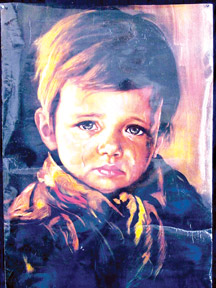
The legend around this painting is as grim as it gets. The stories
began around 1985, when several mysterious fires occurred all around
England. When the debris was sifted through the only item that remained
un-charred was a painting of a little boy with a tear rolling his cheek
in every fire.
Bragolin, who died in 1981 and created a series of Crying Boy
paintings for tourists in post-war Venice. This version claims that the
boy in the painting was an orphan whose parents had died in a fire. He
was taken in by the painter despite warnings that he was a firestarter -
a child who can burn things without touching them.
The artist’s studio caught fire and he was ruined. The boy ran away -
and ten years later a car crashed in flames on the outskirts of
Barcelona. The driver died in the crash, the online story goes, but a
driving licence found inside showed it was the orphan boy.
Research has proved that a flame put immediately in front of the
painting did set fire to a corner of the frame but only burnt around the
outer edge of the child’s profile before petering out. But it turns out
there is a reason why paintings often survive fires relatively
undamaged: It is to do with the string on the back burning through
first. The painting falls face-down, giving it protection from smoke and
heat.

Albert Hall, London

The Royal Albert Hall is a concert hall situated in the South
Kensington area of the Royal Borough of Kensington and Chelsea, London,
England, best known for holding the annual summer Proms concerts since
1941.
The Royal Albert Hall is one of the UK’s most treasured and
distinctive buildings, recognisable all over the world. Since its
opening by Queen Victoria in 1871, the world’s leading artists from
every kind of performance genre have appeared on its stage. Each year it
hosts more than 350 performances including classical concerts, rock and
pop, ballet and opera, tennis, award ceremonies, school and community
events, charity performances and lavish banquets.
The Hall was originally supposed to have been called The Central Hall
of Arts and Sciences, but the name was changed by Queen Victoria to
Royal Albert Hall of Arts and Sciences when laying the foundation stone
as a dedication to her deceased husband and consort Prince Albert.
Sepoy mutiny
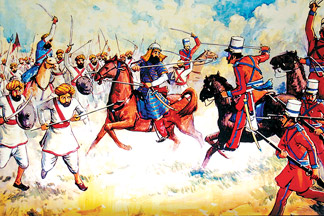
The growing Indian discontent with British rule erupted on May 10,
1857. The Sepoys, who were Indians trained by the British as soldiers,
heard rumours that the cartridges for their new Enfield rifles were
greased with lard and beef fat.
Since the cow is sacred to Hindus and the pig is abhorrent to
Muslims, all the Sepoys were outraged, and they mutinied. Although
initially the mutiny was spontaneous, it quickly became more organized
and the Sepoys even took over the cities of Delhi and Kanpur. This
mutiny was harshly crushed by the British. On September 20, 1857, the
British recaptured Delhi, and in the following months, the British
recaptured Kanpur and withstood a Sepoy siege of Lucknow.
The British victories were accompanied by widespread recrimination
and in many cases, unarmed Sepoys were bayonetted, sown up in the
carcasses of pigs or cows, or fired from cannons.
Zulu

The Zulu are the largest South African ethnic group, with an
estimated 10 to 11 million people living mainly in the province of
KwaZulu-Natal. Small numbers also live in Zimbabwe, Zambia, and
Mozambique. Their language, Zulu, is a Bantu language; more
specifically, part of the Nguni subgroup.
The Zulu were originally a major clan in what is today Northern
KwaZulu-Natal, founded in 1709 by Zulu kaNtombhela. In the Nguni
languages, ‘Zulu’ means ‘heaven’, or ‘sky’. At that time, the area was
occupied by many large Nguni communities and clans. Nguni communities
had migrated down Africa’s east coast over thousands of years, as part
of the Bantu migrations probably arriving in what is now South Africa in
about the 9th Century AD.
The Zulu Kingdom played a major role in South African history during
the 19th and 20th Centuries. Under apartheid, Zulu people were classed
as third-class citizens and suffered from state-sanctioned
discrimination. They remain today the most numerous ethnic group in
South Africa, and now have equal rights along with all other citizens.
Wars of the Roses
|
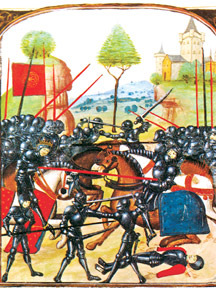
A near-contemporary Flemish picture of the Battle of Barnet
in 1471 |
The Wars of the Roses were a series of dynastic civil wars for the
throne of England, fought between supporters of two rival branches of
the Royal House of Plantagenet: the houses of Lancaster and York, the
‘red’ and the ‘white’ rose, respectively.
They were fought in several sporadic episodes between 1455 and 1485,
although there was related fighting both before and after this period.
The final victory went to a relatively remote Lancastrian claimant,
Henry Tudor, Earl of Richmond, who married Elizabeth of York, the
daughter of the late Yorkist king Edward IV, to reconcile the two
factions and founded the House of Tudor, which subsequently ruled
England and Wales for 117 years.
Sheep gives birth to puppy
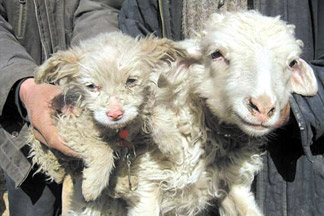
Vets say it’s impossible - but to Chinese farmer Liu Naiying his
birth is a miracle. For Liu insists one of his sheep has given birth to
a dog. The ‘puppy’ has wool like a lamb but its mouth, nose, eyes, paws
and tail look more like a dog’s. His ‘sheep dog’ even plays like a
hound.
The birth has prompted thousands to flock to his farm in Shaanxi
Province to see for themselves.
Mr Liu told how he found the unusual baby animal shortly after it was
born in one of his fields.
‘I was herding the sheep, and saw a sheep licking her newborn lamb on
the grassland. The lamb was still wet,’ he said.
[This day then]
1461
Wars of the Roses:
Battle of Towton – Edward of York defeats Queen Margaret to become
King Edward IV of England
1795
Beethoven,
at age 24, debuts as pianist in Vienna
1798
Republic of Switzerland forms
1827
20,000 attend Ludwig von Beethovens burial in Vienna
1847
Mexican-American War: United States forces led by General Winfield
Scott take Veracruz after a siege
1848
Niagara Falls stops flowing for 30 hours due to an ice jam
1849
Britain formally annexs Punjab after defeat of Sikhs in India
1857
Sepoy Mangal Pandey of the 34th Regiment, Bengal Native Infantry
revolts against the British rule in India and inspires a long-drawn War
of Independence of 1857 also known as the Sepoy Mutiny.
1871
Albert Hall is opened by Queen Victoria in London
1879
Anglo-Zulu War:
Battle of Kambula: British forces defeat 20,000 Zulus
1886
Dr John Pemberton brews the first batch of Coca-Cola in a backyard in
Atlanta, Georgia.
1912
Captain Robert Scott, blizzard-bound in a tent 18 km from the South
Pole, makes last entry in his diary “the end cannot be far”
1927
Henry O D Segrave races his Sunbeam to a record 203.79 mph at
Daytona; 1st auto to exceed 200 mph (322 kph)
1961
After a four and half year trial Nelson Mandela is acquitted on
treason charge
1974
NASA’s Mariner 10 becomes the first spaceprobe to fly by Mercury. It
was launched on November 3, 1973
1994
Serbs and Croats signed a cease-fire to end the war in Croatia
2004
The Republic of Ireland becomes the first country in the world to ban
smoking in all work places, including bars and restaurants
2008
Thirty-five countries and over 370 cities join Earth Hour for the
first time
|



